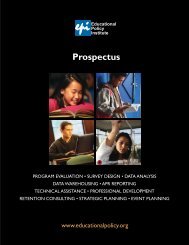A BluePrint for Success: Case Studies of Successful - Educational ...
A BluePrint for Success: Case Studies of Successful - Educational ...
A BluePrint for Success: Case Studies of Successful - Educational ...
Create successful ePaper yourself
Turn your PDF publications into a flip-book with our unique Google optimized e-Paper software.
Data-‐Driven Practices<br />
A Blueprint <strong>for</strong> <strong>Success</strong><br />
Bottom Line tracks students’ college persistence and graduation rates to understand how each student<br />
is progressing towards his or her degree. Data is compared to local, state, and national graduation<br />
rates to measure the success <strong>of</strong> the program services and to measure program outcome against<br />
their goal <strong>of</strong> graduating at least 80 percent <strong>of</strong> Bottom Line students within six years. To assess each<br />
student’s progress towards a degree, Bottom Line categorizes each student as “red,” “green,” or “yellow.”<br />
These categories allow program staff to focus their time and attention on those who need it the<br />
most. In order to obtain in<strong>for</strong>mation from students in the College <strong>Success</strong> Program, Bottom Line<br />
students must sign a FERPA waiver and another contract that allows the organization to contact<br />
their institutions.<br />
The College Access Program tracks in<strong>for</strong>mation such as household income, high school grades,<br />
standardized test scores, and other demographic data. These data elements are used to determine<br />
students’ eligibility <strong>for</strong> the program and their general college readiness. Once students are committed<br />
to the program, Bottom Line tracks their progress through every step <strong>of</strong> the college application process.<br />
Every spring, college acceptance rates are measured, serving as the primary benchmarks <strong>for</strong> the<br />
College Access Program.<br />
In the College <strong>Success</strong> Program, staff members track grades, class schedules, intended and declared<br />
majors, financial aid awards, enrollment, credits, employment, and the overall well being <strong>of</strong> students.<br />
This in<strong>for</strong>mation is collected <strong>for</strong> up to six years while the student is enrolled in college through oneon-one<br />
meetings, phone calls, and emails. Counselors are expected to write an entry into the student<br />
database after each interaction with a student. Frequent communication with the students allows the<br />
counselors to continue to foster a strong relationship with the students, but also allows them to continue<br />
to collect in<strong>for</strong>mation from the students and check in on their general well being. Bottom Line<br />
also uses the National Student Clearinghouse to track student progress <strong>of</strong> students who disengage<br />
from the program.<br />
Twice a year, Bottom Line conducts a <strong>for</strong>mal diagnostic to resolve any problems students have in the<br />
Degree, Employability, Aid, and Life (DEAL) categories <strong>of</strong> the College <strong>Success</strong> Program. Program<br />
staff members identify which students are “red” or “yellow” (i.e. struggling) in any <strong>of</strong> the categories<br />
and then intervene by determining the problem and guiding the student through the steps to overcome<br />
the obstacle. After a problem is resolved (i.e. the student is removed from academic probation),<br />
the student’s status returns to “green,” indicating that he/she remains on track to graduate. This<br />
method allows the staff to provide proactive support to students and measure the effectiveness <strong>of</strong><br />
Bottom Line’s services.<br />
To support these data-driven practices, Bottom Line uses a homegrown web-based database that was<br />
designed with support from a local firm. The system was built specifically <strong>for</strong> the program needs and<br />
helps track in<strong>for</strong>mation such as when students apply online as high school juniors or seniors. The<br />
<strong>Educational</strong> Policy Institute 5 www.educationalpolicy.org




